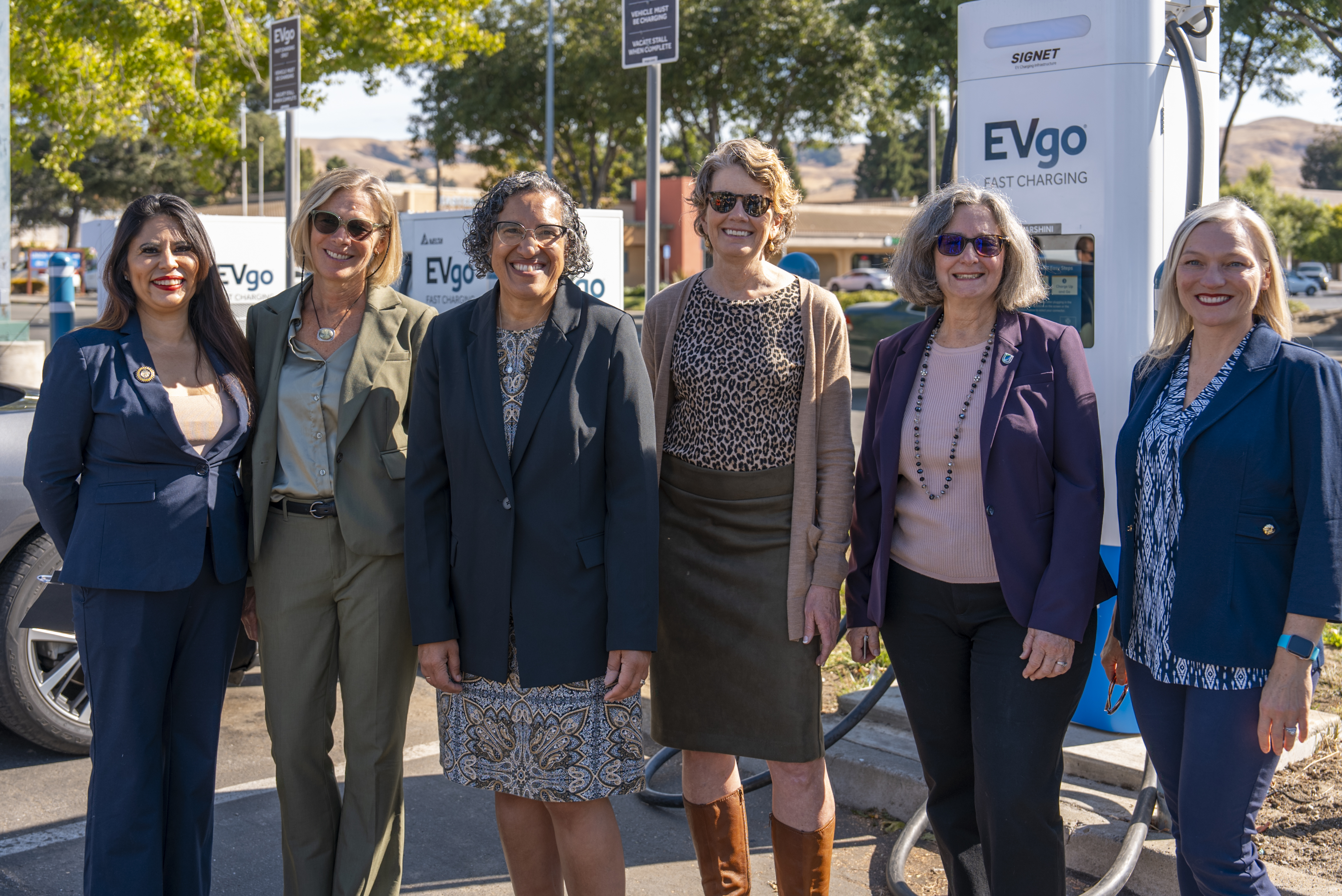For Immediate Release: September 26, 2023
UNION CITY, Calif. — State leaders celebrated achieving the goal of installing 10,000 fast chargers for electric vehicles (EVs) on Monday, more than a year ahead of schedule.
The celebration was held in the parking lot of the El Mercado Plaza Shopping Center in Union City, where newly installed EVgo direct current fast chargers were built using state funds. Chargers like these helped achieve the goal established by then Governor Jerry Brown in 2018. Since that time, the number of fast chargers installed nearly quadrupled from 2,657 to more than 10,000 today.
“We’re really close to this inflection point when it comes to electric transportation,” said California Energy Commission (CEC) Commissioner Patty Monahan. “We’re seeing automakers step up and provide the vehicles and now we need to make sure there is charging infrastructure available to be able to meet demand.”
In attendance to celebrate the milestone were speakers representing various government officials and clean energy leaders, including:
- California State Assemblymember Liz Ortega
- Astrid Scott, District Director of California State Senator Aisha Wahab
- Union City Mayor Carol Dutra-Vernaci
- Chair Liane M. Randolph, California Air Resources Board
- Gia Vacin, Deputy Director, Zero-Emission Vehicle (ZEV) Market Development, Governor’s Office of Business and Economic Development
- Catherine Zoi, CEO, EVgo
Representatives from California Electric Transportation Coalition, the Center for Sustainable Energy, East Bay Community Energy, and Pacific Gas & Electric also attended the event.
“It is so critically important that this infrastructure be for all communities in California so that all residents have the opportunity to experience zero emission transportation,” Randolph said.
Fast chargers can recharge an all-battery EV to 80 percent capacity in about 30 minutes, depending on the size of the vehicle battery and the power level of the charger. The network allows EV drivers to travel across the state with public fast chargers conveniently located along interstates and highways.
The CEC is the lead state agency working to invest in the infrastructure to charge EVs, which are available in plug-in hybrid electric, and battery electric configurations. Building this vast network of chargers is critical in reaching the state’s goal to phase out the sale of gasoline-powered vehicles by 2035.
Through the Clean Transportation Program, the CEC invests in projects that support innovation and accelerate the development and deployment of advanced transportation and fuel technologies. The Legislature recently passed a bill by Assemblymember Eloise Gómez Reyes and Senator Lena Gonzalez that would continue funding for another decade.
“Last year, we approved a $2.9 billion investment plan, with 95% of the money going towards infrastructure for zero emission vehicles,” Monahan said. “In the draft [the CEC] released recently, we are maintaining that level of investment. This is the most money any state has ever allocated for zero-emission vehicle infrastructure."
The program plays an important role in achieving California’s ambitious goals on climate change, petroleum reduction, and adoption of ZEVs, as well as efforts to reduce harmful air pollution. The program also supports the state’s sustainable, long-term economic development.
An effort funded by the Clean Transportation Program is the California Electric Vehicle Infrastructure Project (CALeVIP), the nation’s largest EV charging incentive initiative. CALeVIP addresses local and regional EV charging station needs and supports efforts to meet the state’s ZEV goals.
Since 2017, CALeVIP has provided more than $223 million to fund publicly available Level 2 and DC fast chargers throughout California. CALeVIP funded the EVgo fast chargers showcased at the El Mercado Plaza Shopping Center.
“Right now, in America, there are just over 30,000 fast chargers in the whole country,” Zoi said. “California has [built] about a third of them. California is always leading the way on climate, leading the way on environment and public health, and leading the way on creating jobs for a sustainable economy.”
The second phase of CALeVIP’s Golden State Priority project was recently launched with $38 million available in equity-focused incentives to fund publicly accessible EV charging stations in low-income and disadvantaged communities in 28 counties in northern and southern California.
“We need electric vehicles in communities with families who are working very hard, and who a few years ago could not afford these electric vehicles,” said Assemblymember Ortega. “Today, we are able to [install] chargers in an area that represents working families who are impacted by climate change.”
Through investments like CALeVIP, the CEC is building a corridor of connecting, conveniently located fast chargers that allows EV drivers the freedom to travel throughout the state. This is the largest network of publicly accessible charging stations in the United States.
A replay of the press conference can be viewed on the CEC YouTube page.
# # #
About the California Energy Commission:
The California Energy Commission is leading the state to a 100 percent clean energy future. It has seven core responsibilities: developing renewable energy, transforming transportation, increasing energy efficiency, investing in energy innovation, advancing state energy policy, certifying thermal power plants, and preparing for energy emergencies.
Newsroom
Media Contact
Media and Public Communications Office
MediaOffice@energy.ca.gov
(916) 654-4989

